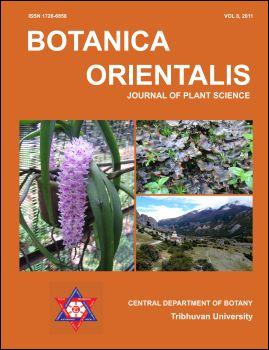Habitat differentiation and population traits variation between the rare Meconopsis napaulensis and the common congener M. paniculata: Implications for rare plant management
DOI:
https://doi.org/10.3126/botor.v8i0.5959Abstract
Understanding the causes of rarity has become increasingly important for the conservation and management of plant species. In this study, we compared spatial distribution, habitat characteristics, and population size and structure of two closely related species of poppy occurring in the Himalaya, the rare and endemic Meconopsis napaulensis and the widespread common congener M. paniculata in order to explain the causes of rarity of the former species. This study was carried out in Langtang National Park, north-central Nepal covering six populations of M. napaulensis and four populations of M. paniculata. Analysis of the habitat features revealed greater tendency of M. napaulensis to exhibit high habitat specificity. It was restricted to nutrient-poor, open and rocky habitats at >3700 m asl. Sites where M. paniculata were sampled showed high variability in terms of edaphic and topographic features. Mean ‘area of occupancy’ tended to be high for M. paniculata compared to M. napaulensis. M. paniculata showed larger population size and greater abundance as compared to M. napaulensis. The poor representation of younger life stages in M. napaulensis despite high proportion of reproductive adults indicated lower recruitment potential. The present study has illustrated that the rarity of M. napaulensis is strongly related to a combination of ecological and geographical constraints, which prevent reproduction, dispersal and colonization. It further demonstrates that the maintenance of population size of rare species largely depends on the survival and abundance of plants of younger stages. Thus, management directed towards reducing the impact on plants of young stages and protecting reproductive individuals from flower and fruit harvesting would help to maintain population size. Finally, development of action plans and guidelines incorporating scientific findings and accommodating local peoples’ socio-economic and cultural factors associated with the extinction risks is imperative for the conservation of rare and endemic species.
doi: http://dx.doi.org/10.3126/botor.v8i0.5959
Botanica Orientalis – Journal of Plant Science (2011) 8: 57-69
Downloads
Downloads
How to Cite
Issue
Section
License
This license enables reusers to copy and distribute the material in any medium or format in unadapted form only, for noncommercial purposes only, and only so long as attribution is given to the creator.




